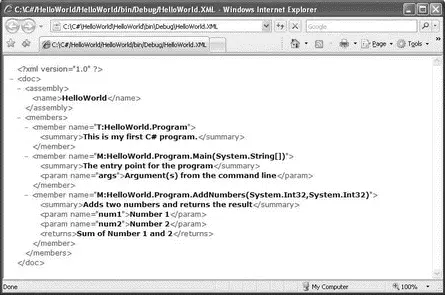///
/// The entry point for the program
///
///
static void Main(string[] args) {
Console.Write("Hello, ");
for (int i = 0; i < args.Length; i++)
Console.Write("{0} ", args[i]);
Console.Write("! This is my first C# program!");
Console.ReadLine();
return;
}
///
/// Adds two numbers and returns the result
///
/// Number 1
/// Number 2
/// Sum of Number 1 and 2
private int AddNumbers(int num1, int num2) {
//---implementations here---
}
}
}
To enable generation of the XML document containing the XML comments, right-click the project name in Solution Explorer and select Properties.
You can also generate the XML documentation file using the csc.execompiler at the command prompt using the /docoption:
csc Program.cs /doc:HelloWorld.xml
In the Build tab, tick the XML Documentation File checkbox and use the default path suggested: bin\Debug\HelloWorld.XML(see Figure 3-7).

Figure 3-7
Build the project by right-clicking the project name in Solution Explorer and selecting Build.
You will now find the HelloWorld.xmlfile (see Figure 3-8) located in the bin\Debug\ folder of the project.

Figure 3-8
You can now convert this XML file into a MSDN-style documentation file. Appendix C shows you how to use the SandCastle tool to do this.
C# is a strongly typed language and as such all variables and objects must have a declared data type. The data type can be one of the following:
□ Value
□ Reference
□ User-defined
□ Anonymous
You'll find more information about user-defined types in Chapter 4 and about anonymous types in Chapter 14.
A value type variable contains the data that it is assigned. For example, when you declare an int (integer) variable and assign a value to it, the variable directly contains that value. And when you assign a value type variable to another, you make a copy of it. The following example makes this clear:
class Program {
static void Main(string[] args) {
int num1, num2;
num1 = 5;
num2 = num1;
Console.WriteLine("num1 is {0}. num2 is {1}", num1, num2);
num2 = 3;
Console.WriteLine("num1 is {0}. num2 is {1}", num1, num2);
Console.ReadLine();
return;
}
}
The output of this program is:
num1 is 5. num2 is 5
num1 is 5. num2 is 3
As you can observe, num2is initially assigned a value of num1(which is 5). When num2is later modified to become 3, the value of num1remains unchanged (it is still 5). This proves that the num1and num2each contains a copy of its own value.
Following is another example of value type. Point is a structure that represents an ordered pair of integer x and y coordinates that defines a point in a two-dimensional plane (structure is another example of value types). The Pointclass is found in the System.Drawingnamespace and hence to test the following statements you need to import the System.Drawingnamespace.
Chapter 4 discusses structures in more detail.
Point pointA, pointB;
pointA = new Point(3, 4);
pointB = pointA;
Console.WriteLine("point A is {0}. pointB is {1}",
pointA.ToString(), pointB.ToString());
pointB.X = 5;
pointB.Y = 6;
Console.WriteLine("point A is {0}. pointB is {1}",
pointA.ToString(), pointB.ToString());
These statements yield the following output:
point A is {X=3,Y=4}. pointB is {X=3,Y=4}
point A is {X=3,Y=4}. pointB is {X=5,Y=6}
As in the earlier example, changing the value of the pointB does not change the value of pointA.
Predefined Value Types
The .NET Framework ships with a set of predefined C# and .NET value types. These are described in the following table.
| C# Type |
.NET Framework Type |
Bits |
Range |
bool |
System.Boolean |
|
True or false |
byte |
System.Byte |
8 |
Unsigned 8-bit integer values from 0 to 255 |
sbyte |
System.SByte |
8 |
Signed 8-bit integer values from -128 to 127 |
char |
System.Char |
16 |
16-bit Unicode character from U+0000 to U+ffff |
decimal |
System.Decimal |
128 |
Signed 128-bit number from ±1.0×10 -28to ±7.9×10 28 |
double |
System.Double |
64 |
Signed 64-bit floating point number; approximately from ±5.0×10 -324to ±1.7×10 308 |
float |
System.Single |
32 |
Signed 32-bit floating point number; approximately from ±1.5×10 -45to ±3.4×10 38 |
int |
System.Int32 |
32 |
Signed 32-bit integer number from -2,147,483,648 to 2,147,483,647 |
uint |
System.UInt32 |
32 |
Unsigned 32-bit integer number from 0 to 4,294,967,295 |
long |
System.Int64 |
64 |
Signed 64-bit integer number from -9,223,372,036,854,775,808 to 9,223,372,036,854,775,807 |
ulong |
System.UInt64 |
64 |
Unsigned 64-bit integer number from 0 to 18,446,744,073,709,551,615 |
short |
System.Int16 |
16 |
Signed 16-bit integer number from -32,768 to 32,767 |
ushort |
System.UInt16 |
16 |
Unsigned 16-bit integer number from 0 to 65,535 |
To declare a variable of a predefined type, you can either use the C# type or the .NET Framework type. For example, to declare an integer variable, you can either use the int or System.Int32type, as shown here:
int num1 = 5;
//---or---
System.Int32 num2 = 5;
To get the type of a variable, use the GetType()method:
Console.WriteLine(num1.GetType()); //---System.Int32---
To get the .NET equivalent of a C# type, use the typeof()method. For example, to learn the .NET type equivalent of C#'s float type, you can use the following statements:
Type t = typeof(float);
Console.WriteLine(t.ToString()); //---System.Single---
Читать дальше














